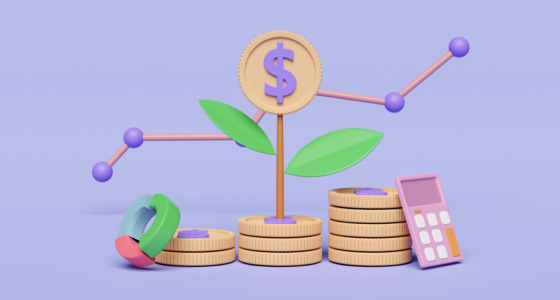

One categorization that helps investors make better decisions about the stocks they invest in is a stock’s market cap. This article will guide you about the differences between small-cap, mid-cap, and large-cap stocks and what they mean for your investments.
Let’s start by first learning about what role the market cap plays in the stock market before going into each category in detail.
Market capitalization: meaning and categories
A company’s market capitalization is an estimated measure of its total value. It is calculated by multiplying the total number of outstanding shares of a company in the market by the current price of each share.
Let us use an example to understand the meaning of market cap better.
Market cap example
The ABC company has 20 million outstanding shares in the market, and each share is priced at Rs 50. The market capitalization of the company will thus be calculated as follows:
Outstanding shares x Price per share = 20 million x 50 = Rs 1 billion
With these calculations, the market capitalization of the ABC Company turns out to be Rs 1 billion.
So, the companies traded on the stock market in India (or other countries) can be categorized broadly into large-cap, mid-cap, and small-cap. Also, you can find shares of micro-cap companies on the Indian stock exchange. Let’s now dive into how different a large-cap company vs. a mid-cap company is.
Note! Market capitalization is often abbreviated and referred to as “market cap”.
What is a large-cap stock?
Large-cap companies are those that are very well-established, meaning they have an exceptionally high market share. In the case of India, companies with a market cap of Rs 20,000 crores or more are considered to be large-cap companies. These organizations dominate the industry and are considered to be very stable. They will usually have been around for decades. Big caps manage well, even during international or national recessions or events that might see other companies underwater.
For an investor wanting to invest in stocks with minimal risk, large-cap stocks make for an excellent option because they are less volatile in comparison to mid-cap and small-cap stocks. Their low volatility makes them relatively less risky investments.
Some of the most well-known examples of large-cap market companies in India are Reliance Industries and Infosys. They have a strong foothold in the stock exchanges and have a consistent track record, making them a recommended addition to any investor’s portfolio.
What is a mid-cap stock?
Mid-cap companies have a market cap above Rs 5,000 crore but lower than Rs 20,000 crore. Mid-caps tend to be more volatile than large-caps, meaning investing in them is riskier than large-cap market companies.
However, mid-cap companies also have the potential to grow into large-cap companies in the future. Since their relative growth potential to their current value than large-cap stocks, they make attractive investments to investors looking to take a risk for growth.
Some mid-cap companies listed on the Indian stock exchange are Metropolis Healthcare, LIC Housing Finance, and Castrol India.

What is a small-cap stock?
All public companies with a total market cap of less than Rs 5,000 crore are said to be small-cap, meaning they are significantly smaller than the giants with high-cap stocks.
Their growing nature means they can give back significant returns. However, they are much riskier to invest in as the probability that they will be successful over time is quite low. It is because of the volatile nature of these companies. Small-cap companies often underperform and are most likely to go under in case the economy slows down. However, some successful companies also tend to see the highest growth rate when an economy begins to thrive after a recession.
Some small-cap market companies listed on the stock exchanges of India (like NSE) are Hindustan Zinc, KNR Constructions, DB Corp, and Hathway Cable.
Small-cap vs. mid-cap vs. large-cap companies
Let’s now discuss the difference in characteristics between small-cap, medium-cap, and large-cap companies.
H3 – Company reputation
Large-cap companies are well-established in the equity market. They have tried and tested business models with reliable management and tend to rank in the top 100 companies in the country. Mid-cap companies are compact and sit in between large-cap and small-cap companies. They usually rank among the country’s top 100 to 250 companies. Lastly, small-cap companies have a much smaller size, with the potential to expand rapidly.
Market capitalization
Large-cap companies have values with a market cap of Rs 20,000 crore or more. The market cap of mid-cap companies, on the other hand, is between Rs 5,000 crore and Rs 20,000 crore, with small-cap companies having a lower market cap of below Rs 5,000 crore.
Volatility
The risk associated with investing in a company is directly related to its volatility. If the stock’s price holds its value even in turbulent markets, it is said to have low volatility. In contrast, stocks that see widely varying values at times are termed as highly volatile.
The value of large-cap companies tends to be less volatile, meaning even though their value might fall temporarily, they will remain relatively stable even amid a troubled economy. It makes them quite safe and reliable investments with relatively low risk.
Mid-cap stocks are usually more volatile than large-cap stocks and are associated with a higher risk. Finally, small-cap companies are very volatile, with their prices swinging considerably, increasing the risk for investors.
Growth potential
The difference in growth potential between small-cap and large-gap companies is significant. Though large-cap stocks are well suited to low-risk investors, they have a constant but relatively slow growth rate. On the other hand, mid-cap and successively small-cap companies are riskier but have a higher potential for growth (and loss).
Liquidity
The finance term “liquidity” is used to convey how quickly and easily investors can buy or sell stocks without affecting the share price. Since large-cap shares have a high demand in the stock market, they have the most increased liquidity. Thus, selling off positions is easier when you decide to. On the other hand, mid-cap companies have lower liquidity, while small-cap companies have the least liquidity, making trading off positions more difficult.
Mutual funds and market capitalization
Mutual funds are an integral part of almost every economy. These fund schemes can also be categorized using the market cap system, meaning small-cap, mid-cap, or large-cap funds. For example, what is a large-cap mutual fund? It is a fund that will invest mainly in large-cap stocks. Small-cap and mid-cap schemes will thus invest in small-cap and mid-cap stocks, respectively.
Risk difference between small-cap, mid-cap, and large-cap funds
So, how do you choose the best mutual fund scheme to invest in? A significant part of your decision-making should be your risk tolerance.
What is the risk in small-cap funds?
As the investment focus of such mutual funds is small-cap companies, the risk exposure is high with these funds because small-cap companies are not established, thriving businesses. They are in their essential periods of growth and might struggle to stay afloat during a recession.
However, if the small-cap manages to do well, the growth rate can be higher than other mid-caps and large-cap investments. Small-cap funds try to take advantage of this possibility: with the higher risk, there is a chance of relatively higher returns.
What is the risk in mid-cap funds?
Mid-cap funds have a slightly higher potential for growth and, thus, the chance of relatively higher mutual fund returns. However, there is a higher risk as mid-cap companies are less strong at coping with market volatility than large-caps. The main objective for the fund manager is to invest funds in mid-cap companies with a high chance of success in the future.
What is the risk in large-cap funds?
Blue-chip companies make up the majority of investments by large-cap funds. Thus these funds inherit their advantages: Since the companies they invest in are stable businesses, the fund also has the strength to weather market volatility. The high demand for these stocks also makes them very liquid. With the low risk comes a slow growth rate, and these funds usually bring modest yet consistent returns in the long run.
Role of market capitalization in your portfolio
Hopefully, you will have now understood the important role market capitalization plays while putting together your investment portfolio. The performance of large-gap, mid-cap, and small-cap stocks changes greatly depending on the state of the economy. When large-cap stocks are not doing well, mid-cap and small-cap stocks could be on the rise. On the other hand, when mid-cap or small-cap plummet during the start of a recession, the large-cap companies in your portfolio could steady overall returns.
The bottom line
It is essential to diversify your portfolio by investing in all market caps. It will help your portfolio cope with changing market conditions and generate returns. Consider your financial goals, appetite for risk, and investment period before investing in anything. Opening an account with a large broker also can help you immensely if you need more knowledge or support. It will get you access to professional market research and analysis and a vast knowledge base.
FAQs
If you still have questions about what is a large/mid/small cap company and whose stocks are best to buy in India, look for answers below.
Do large-cap companies have lower growth potential?
Yes. The strong stability of large-cap companies generally means they have lower growth potential than mid-cap and small-cap companies.
What is the formula to calculate the market capitalization of a specific company?
To determine a company’s market capitalization, simply multiply the number of all its outstanding shares by the current price of each share.
If the total number of shares were 1,000 and the price of each share was Rs 200, then the company’s market cap would be 1000 X 200 = 200,000 (Rs 2 lakh).
Who should invest in small-cap funds?
An aggressive investor with a high-risk tolerance looking for potentially higher gains should invest in a small-cap fund. However, do adopt due diligence before investing anywhere.
How do I choose a small-cap stock?
One can choose small-cap stocks (or any stock) by keeping a lookout for the following:
- The company’s financial strength. Choose a financially sound company with consistent profits, healthy margins, low debt, and proper equity management.
- Company’s sales and profits. Check the company’s earnings for at least the last five years. Investing in a company’s stock with consistent sales and improving profitability year-on-year is wise.
- Quality management. Carry out an extensive background check on the company’s leaders and investors and invest if you’re confident in their leadership and vision.
Is it better to invest in mid-cap or large-cap?
It depends heavily on your risk tolerance. Mid-cap stocks tend to be riskier investments than large-cap stocks and have a higher chance of offering higher returns than large-cap stocks. On the other hand, large-cap stocks are tired and tested machines structured to handle volatility. Stick to them if you want to minimize the risk of loss.











